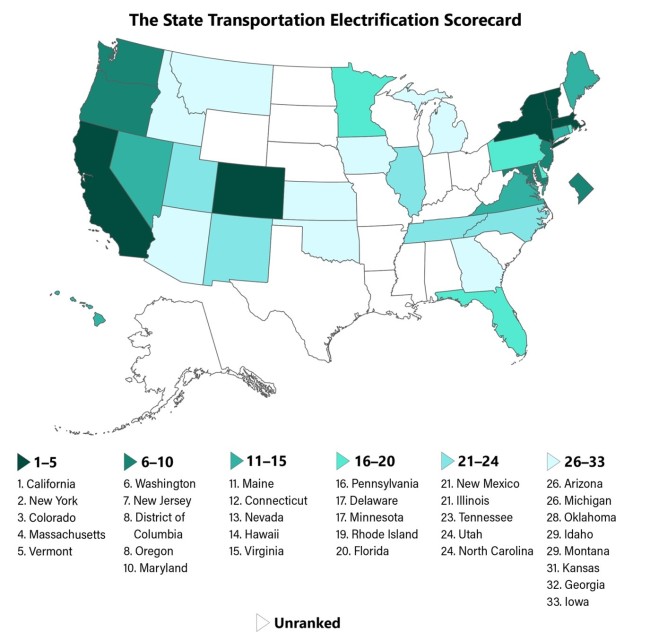Washington, DC—Leading states are strengthening policies to enable widespread use of electric cars, trucks, and buses, but all states will have to dramatically step up their efforts to enable a full transition, a new report finds. The 2023 State Transportation Electrification Scorecard from the American Council for an Energy-Efficient Economy (ACEEE) evaluates states’ policies to encourage electric vehicle (EV) adoption. Only nine states scored more than half the points available.
“We are seeing incremental progress, not transformational progress. States will have to move far more aggressively to do their part to enable the electric vehicle transition that the climate crisis demands,” said Peter Huether, senior research associate at ACEEE and lead author of the report. “Auto manufacturers are expanding their EV options and consumers are increasingly choosing them, but supportive state policies are needed to ensure that the electric grid is ready and that all households and businesses, including those in underserved communities, can use EVs and have adequate access to charging.”
California ranked first in the Scorecard, scoring 88 out of 100 points. The Golden State has committed to full electrification of light-duty vehicle sales, is planning significant updates to its electricity grid to prepare for a sharp rise in EVs, and incorporates equity considerations into its EV policy, setting aside significant funding for EV purchases in low-income communities and communities of color. New York, which came in second with 62 points, has heavily incentivized the purchase of EVs and EV charging infrastructure, including from its investor-owned utilities, and has taken considerable steps to integrate EVs onto the grid. Rounding out the top 10 are Colorado (#3), Massachusetts (#4), Vermont (#5), Washington State (#6), New Jersey (#7), the District of Columbia (tied for #8), Oregon (tied for #8), and Maryland (#10). The top nine states scored more than 50 points, and all others scored less than half the points available.
Since ACEEE’s last assessment of state EV policies in 2021, California finalized two important EV regulations: the Advanced Clean Cars II rule, which requires all new cars sold by 2035 to be EVs, and the Advanced Clean Truck regulation, which requires heavy-duty truck sales to begin to transition to electric models. Six states have adopted California’s Advanced Clean Cars II rule, and seven adopted its truck rule. Six additional states are considering adopting one or both of the rules. Nationwide, utilities have committed to invest $760 million in vehicle charging infrastructure since the last scorecard. The number of states requiring transit agencies to electrify their buses has doubled from four to eight.
In many areas, significant improvement is needed. Most states do not have targets to reduce emissions from the transportation sector, and since the last scorecard, only Colorado added such a goal. Only four states have set binding targets to electrify school buses, and only two of those prioritize equity in those targets. Seventeen states offer purchase incentives for heavy-duty electric vehicles, down from 27 in 2021 because some states allowed funding for the incentives to expire.
States overall scored poorly on equity metrics in the Scorecard. Only California scored more than half the equity points. Few states other than California have made significant investments to ensure that electric vehicles and charging are available in underserved communities.
The Scorecard only presents scores for the top 33 states, because the remaining states achieved very few points, and there is little differentiation in policy progress among those states.
As passenger EV sales continue to grow and federal purchase incentives encourage domestic manufacturing, some states have subsidized EV and battery manufacturers in order to lure jobs. But many of those states underperform on enabling drivers to transition to EVs. Of the six states that have provided more than a billion dollars in incentives for manufacturers, only two score in the top half of states.
|
State |
Manufacturer Subsidies |
Scorecard Rank |
|
Georgia |
$3.6 billion |
32 |
|
North Carolina |
$2.1 billion |
23 |
|
Michigan |
$2.1 billion |
26 |
|
Nevada |
$1.3 billion |
13 |
|
Kansas |
$1.3 billion |
31 |
|
Tennessee |
$1.2 billion |
27 |
|
Source for subsidy figures: Good Jobs First report, October 2022 |
||
The report recommends that underperforming states collect data on transportation electrification—such as EV registrations, charger locations, and EV adoption by race and income—and use the information to help improve their transportation electrification planning. States can take advantage of federal funding from the Inflation Reduction Act of 2022 and the 2021 bipartisan infrastructure law to help coordinate planning and deployment of charging infrastructure. The report also recommends that states encourage private investment in EV charging. Many states can make further progress on transportation electrification by adopting California’s EV rules, offering incentives for EV purchases, codifying targets for the deployment of EVs and chargers, and ensuring that utility funding is set aside for underserved populations.
The Scorecard is primarily based on a review of state policies effective by February 15, 2023. Some states, such as Colorado and Minnesota, have since passed laws to encourage EV adoption that are not factored into the scoring.


